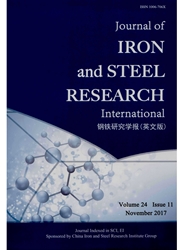

 中文摘要:
中文摘要:
对铜渣氯化焙烧过程中各主要组分的反应热力学行为进行了理论分析.热力学分析结果表明,CaCl2为氯化剂对铜渣进行氯化焙烧时,其自身离解须在有氧环境中并在铜渣中SiO2组分的作用下才可发生,且反应体系中介入FeSO2,可较大程度促进CaCl2的离解.渣中含铜物相Cu2O、Cu2S及CuS在焙烧温度下可发生氯化反应,含铁物相Fe3O4和Fe2SiO4两者的氯化反应则不可发生,即过程可实现铜渣的选择性氯化.所形成氯化物挥发过程中,单一氯化物可发生聚合反应,且所形成聚合物的蒸汽压比单一氯化物相对较高.
 英文摘要:
英文摘要:
Thermodynamic analysis of copper residue main components in chlorination roasting process was studied in this paper.The results show that dissociation of CaCl2 is able to be realized with the help of SiO2 in the copper slag and O2,and its dissociation degree increases with FeSO4 addition.The copper phases in the copper slag,Cu2O,Cu2S and CuS,can be chlorinated at the roasting temperature.However,the iron phases,Fe3O4 and Fe2SiO4,can not be chlorinated which means that the selective chlorination of copper slag can be realized in this process.During the volatilization process of the chlorides,the single chloride gets together and forms polymer,tension of which is larger than the single chloride.
 同期刊论文项目
同期刊论文项目
 同项目期刊论文
同项目期刊论文
 期刊信息
期刊信息
